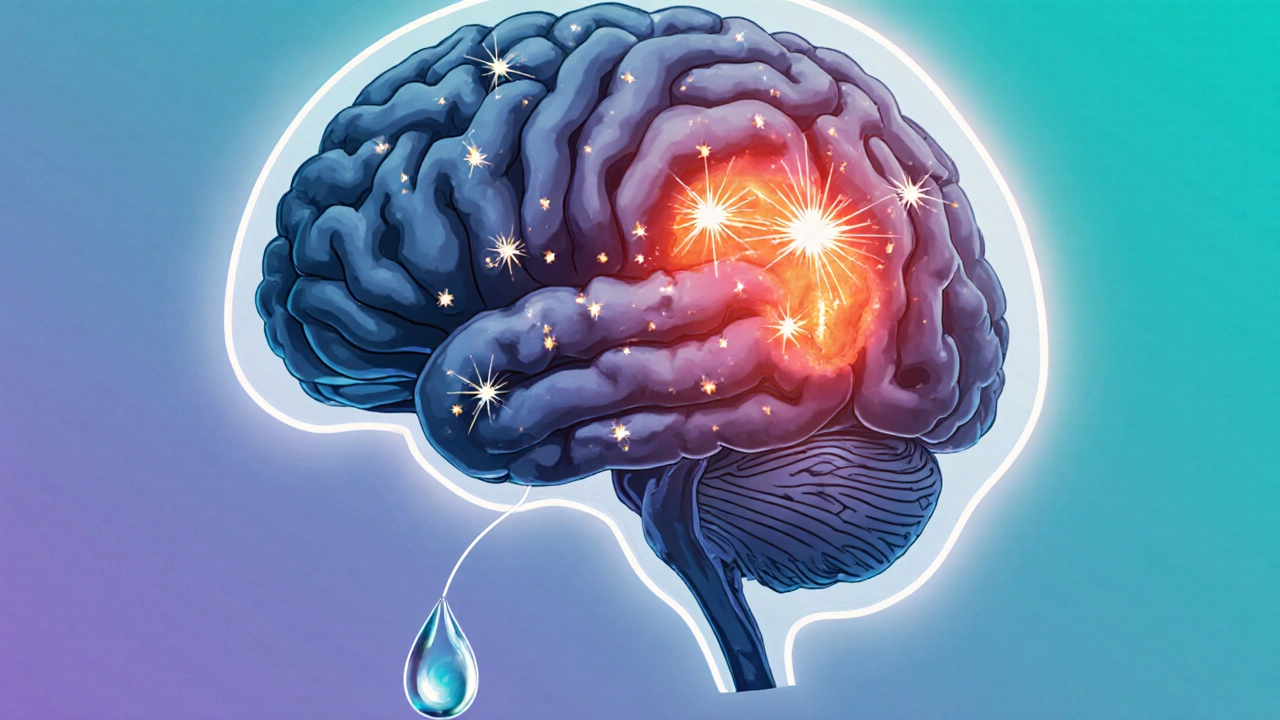Why ADHD Makes You Cry Easily - Understanding Emotional Sensitivity
 Oct, 26 2025
Oct, 26 2025
ADHD Emotional Coping Strategy Finder
This tool helps you identify the most effective coping strategies for your specific ADHD-related emotional sensitivity. Answer a few questions about your triggers, co-occurring conditions, and current coping methods to receive personalized recommendations.
What are your primary emotional triggers?
Do you experience any co-occurring conditions?
What coping strategies do you currently use?
How often do you experience emotional overload?
Personalized Coping Strategies
Important: These recommendations are based on your responses. For severe emotional distress, please consult a healthcare professional.
Key Takeaways
- ADHD often comes with heightened emotional sensitivity that can trigger tears over small stressors.
- Brain chemistry (low dopamine, overactive amygdala) and executive‑function challenges play a big role.
- Co‑occurring anxiety or depression can amplify tearfulness.
- Practical coping tools - mindfulness, structured routines, CBT, and medication when needed - can lessen the frequency of emotional overload.
- Seek professional help if crying interferes with work, relationships, or daily functioning.
Ever felt like a tiny annoyance turns into an avalanche of tears? If you have ADHD is a neurodevelopmental condition that affects attention, impulse control, and emotional regulation. Many people with ADHD report that they "cry easily" - a phrase that sounds simple but actually hides a complex mix of brain chemistry, learned habits, and everyday stressors.
Understanding why this happens isn’t just a curiosity; it gives you tools to calm the storm before it breaks. Below we break down the science, share real‑world scenarios from India, and list actionable steps you can try today.
What is ADHD?
ADHD is a neurodevelopmental disorder characterized by persistent patterns of inattention, hyperactivity, and impulsivity that interfere with daily life. It affects roughly 5‑7 % of children worldwide, and many continue to experience symptoms into adulthood. While most discussions focus on difficulty concentrating, emotional regulation is a core, often overlooked, component.
Why Emotional Sensitivity Is Common in ADHD
Three main brain mechanisms make emotional reactions more intense for people with ADHD:
- Dopamine deficiency. Dopamine, the "feel‑good" neurotransmitter, also helps the brain filter out irrelevant stimuli. Low dopamine levels mean emotional triggers aren’t filtered as efficiently, so a mild frustration can feel overwhelming. Dopamine is a neurotransmitter that regulates reward, motivation, and attention plays a double‑duty in mood.
- Prefrontal‑cortex overload. The Prefrontal cortex is the brain region responsible for planning, impulse control, and emotional regulation requires steady dopamine to function smoothly. When dopamine is low, this area struggles to keep the amygdala (the "fight‑or‑flight" center) in check, leading to quicker tear responses.
- Executive‑function fatigue. Managing schedules, emotions, and tasks taxes Executive function refers to mental skills for goal‑directed behavior, such as organizing, prioritizing, and self‑monitoring. When the brain is constantly juggling, emotional bandwidth shrinks, so even a small setback can feel like a crisis.

How ADHD Triggers Crying
Beyond the core neurobiology, everyday life adds layers that tip the balance:
- Co‑occurring anxiety. Many with ADHD also battle Anxiety a feeling of worry, nervousness, or unease about an imminent event or something with an uncertain outcome. Anxiety heightens emotional reactivity, turning a missed deadline into a tearful episode.
- Depression. Persistent low mood can lower the threshold for crying. Depression is a mood disorder characterized by persistent sadness, loss of interest, and reduced energy often co‑exists with ADHD, especially in adults.
- Stress hormones. Cortisol spikes during chronic stress, and ADHD‑related disorganization often leads to longer stress periods. Elevated cortisol can make you feel more vulnerable and emotionally raw.
- Social misunderstanding. In India, cultural expectations sometimes label emotional expression as "weakness". When others dismiss your feelings, you may internalize frustration, which later erupts as tears.
Real‑World Scenarios (Indian Context)
Imagine Riya, a 28‑year‑old graphic designer in Delhi. She forgets to submit a client brief on time, feels the familiar rush of guilt, and a colleague comments, "You always mess up". For most people, the comment might sting briefly. For Riya, dopamine levels are already low, her prefrontal cortex is overloaded from juggling freelance projects, and she also has mild anxiety about job security. Within minutes, she finds herself crying in the office bathroom.
Or consider Arjun, a 15‑year‑old student in Mumbai who struggles with homework organization. A missed math assignment leads to a stern talk from his father. The emotional response is immediate and intense, leaving him feeling embarrassed in front of classmates.These stories illustrate how ADHD‑related brain patterns intersect with everyday pressures, turning routine setbacks into emotionally charged moments.
Practical Strategies to Manage Tearfulness
Below is a toolbox of evidence‑based methods. Pick what feels right for your lifestyle and try them consistently.
| Strategy | What It Does | Typical Effectiveness |
|---|---|---|
| Mindfulness meditation | Reduces amygdala reactivity, improves dopamine regulation | High |
| Structured routines (time‑blocking) | Lowers executive‑function load, creates predictability | Medium‑High |
| Cognitive Behavioral Therapy (CBT) | Reframes negative thoughts, builds coping phrases | High |
| Physical exercise (aerobic) | Boosts dopamine and endorphins, reduces cortisol | Medium |
| Medication (stimulants or non‑stimulants) | Increases dopamine availability, stabilizes mood | Variable (depends on individual response) |
Emotional sensitivity isn’t a flaw; it’s a signal that your brain needs extra support. Here’s how to apply the tools:
- Start with 5 minutes of mindfulness each morning. Apps like Insight Timer offer guided sessions tailored for ADHD.
- Use a visual planner (whiteboard, sticky notes) to externalize tasks, reducing the load on executive function.
- Practice CBT thought‑record sheets: when you feel tears coming, write down the trigger, the automatic thought, and a balanced alternative.
- Move daily: a brisk 20‑minute walk or a short yoga flow can raise dopamine levels naturally.
- Consult a psychiatrist if crying feels uncontrollable despite lifestyle changes; medication may be a helpful adjunct.

When to Seek Professional Help
Even with strategies, some signs indicate it’s time to get expert support:
- Frequent crying that interrupts work or study for more than a few minutes.
- Feelings of hopelessness, worthlessness, or thoughts of self‑harm.
- Physical symptoms like chronic headaches, stomachaches, or sleep disturbances linked to emotional episodes.
A qualified therapist familiar with ADHD can tailor interventions, and a psychiatrist can evaluate whether medication might improve emotional regulation.
Connecting to Sad Poetry
India has a rich tradition of sad poetry (dard bhari kavita) that gives voice to deep feelings. Many with ADHD find solace in verses that capture the intensity they experience. Reading a line like "बाहर की दुनिया से क्यों मैं दूर हूँ" (Why am I distant from the world?) can normalize the emotional surge and turn tears into artistic expression.
Consider writing your own short poem after a tearful moment. It helps externalize the feeling, creating a bridge between raw emotion and creative release.
Quick Checklist
- Identify the top three triggers that make you cry.
- Set a daily 5‑minute mindfulness habit.
- Organize tasks on a visual board.
- Try a CBT worksheet for negative thoughts.
- Schedule a doctor’s visit if crying persists.
Why do people with ADHD cry more often?
ADHD affects dopamine levels and the prefrontal cortex, which makes it harder to filter emotional stimuli. Combined with anxiety or depression, small stressors can trigger a strong tear response.
Can medication reduce tearfulness?
Stimulant or non‑stimulant meds increase dopamine availability, often stabilizing mood and reducing emotional spikes. Effectiveness varies, so a psychiatrist’s guidance is essential.
What role does mindfulness play?
Mindfulness trains the brain to notice emotions without instantly reacting, which can lower amygdala activity and improve dopamine regulation over time.
How can I use poetry to cope?
Reading or writing sad poetry gives a safe outlet for intense feelings, turning raw tears into creative expression and reducing internal pressure.
When should I see a therapist?
If crying interferes with work, school, or relationships, or if you notice persistent sadness, hopelessness, or self‑harm thoughts, it’s time to seek professional help.